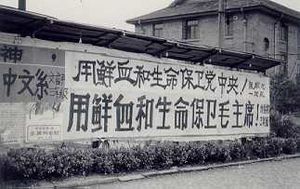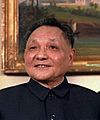Cultural Revolution facts for kids
The Cultural Revolution was a big change in China that lasted from 1966 to 1976. It was started by Mao Zedong, who was the leader of the Communist Party of China. This period brought many changes to Chinese society and culture.
The Cultural Revolution began after a difficult time called the Great Leap Forward. Mao Zedong wanted to remove people he called "capitalists" from the Communist Party. These were people he believed were not following the true path of Socialism. To do this, he started a program called the Socialist Education Movement. This movement ran from 1962 to 1965. During this time, the school system was also changed. The goal was to make sure students could also work in factories and farms.
By 1965, Mao Zedong started to get more power again. He had the support of important people like Lin Biao, Jiang Qing, and Chen Boda. The Communist Party was divided between those who supported Mao and those who supported Deng Xiaoping, who was a rival of Mao.
Mao Zedong wanted to get young people on his side. He did this by creating a book called Quotations from Chairman Mao Zedong, also known as the Little Red Book. This book was full of his sayings. He also made a group called the Red Guards very popular. The Red Guards were young people who traveled around China. They spread Mao's ideas and sometimes caused trouble. They damaged old buildings and museums. There were many conflicts, and China faced a time of disorder. Many important leaders, like Liu Shaoqi (who was the President of China) and Deng Xiaoping, were removed from their positions.
The Cultural Revolution started to slow down in 1967. It officially ended in 1969, when the Ninth National Party Congress announced its conclusion.
Contents
Impacts of the Cultural Revolution
The Cultural Revolution caused many problems across China. It affected the country's economy, education, and daily life.
Effects on China's Economy
The Cultural Revolution hurt China's ability to produce goods. Factories made less because workers were busy with political activities. Also, the people put in charge of factories often did not know how to run them well. Moving goods around the country became harder. Many trains were used to carry Red Guards instead of important supplies. Many smart people, like scientists and engineers, were sent to work on farms or put in jail. This meant their valuable knowledge was lost. Because of these issues, China's industrial output went down by 14 percent.
Effects on Education and Learning
The education of many Chinese people was also stopped or cut short. Schools and universities were closed, especially in cities. A program called the "sent-down youth" program also disrupted learning. In this program, young people from cities were sent to live and work in the countryside. This meant they missed out on their studies.
Related pages
Images for kids
-
People in the countryside working at night to produce steel during the Great Leap Forward
-
Mao Zedong waving to people before his "swim across the Yangtze"
-
Mao Zedong and Lin Biao with cheering Red Guards in Beijing.
-
Tiananmen Square on September 15, 1966, during one of Mao's large meetings with Red Guards.
-
Marshal Lin Biao was named Mao's official successor in 1969.
-
Jiang Qing (left), Mao Zedong's wife, with Premier Zhou Enlai (center) and Kang Sheng, meeting Red Guards in Beijing. They are holding the Little Red Book.
-
Deng Xiaoping became China's top leader in 1978. He helped bring the country back to order and started major economic reforms.
-
A public criticism meeting for Xi Zhongxun, the father of Xi Jinping (September 1967).
-
The Tibetan Panchen Lama during a public criticism meeting.
-
Yao Tongbin, a top Chinese missile scientist, was killed by a mob during the Cultural Revolution (1968).
-
Parts of a banner with slogans from the Cultural Revolution in Anhui.
See also
 In Spanish: Revolución Cultural para niños
In Spanish: Revolución Cultural para niños

























